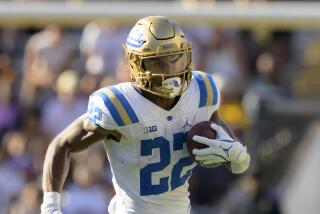COLLEGE FOOTBALL: THE BOWL GAMES : A TALE OF TAPE : Ball Has Everything but Durability
- Share via
DALLAS — Eric Ball didn’t think too far ahead on the day that he ran for 227 yards and 4 touchdowns in UCLA’s 45-28 Rose Bowl victory over Iowa in 1986.
“I was tired,” he said. “I was thinking of going home, getting something to eat and going to bed.”
It wasn’t until about 2 months later, after he had watched the game on videotape for the first time, that the redshirt freshman realized that his performance might prove to be an albatross, an unyielding standard by which all his achievements would be measured.
Looking ahead to the Bruins’ opener against Oklahoma the next season, he set out to duplicate his feat against an even more prestigious foe. “I wanted to play well so no one would say, ‘That (Rose Bowl) was a once-in-a-lifetime thing,’ ” Ball said.
Ball, though, missed the Oklahoma game with a knee injury, a harbinger of things to come.
It seems somewhat appropriate that Ball, who will play his last game for UCLA Monday against Arkansas in the Cotton Bowl, is a geography major.
His career has been all over the map: From the heights of Jan. 1, 1986, to the depths of running for only 493 yards in his next 2 seasons ; from the heights of running for 148 yards in the Bruins’ 41-28 victory over Nebraska this season to the depths of contributing only pass-blocking protection for quarterback Troy Aikman in UCLA’s 31-22 season-ending loss to USC.
An ankle injury limited his participation against the Trojans and probably cost him a 1,000-yard season. He rushed for 781 yards and 6 touchdowns in 164 carries, a 4.8-yard average, before injuring his right ankle in the second quarter against Oregon in the Bruins’ ninth game. He didn’t carry the ball again.
The injury also raised new doubts among National Football League scouts about his durability, although they seem to like everything else about him.
Of the running backs who will be eligible for the draft, probably only tailback Eric Metcalf of Texas and fullback Cleveland Gary of Miami will be taken before Ball, said Joel Buchsbaum of Pro Football Weekly.
Big and strong, the 6-foot 2-inch, 216-pound Ball has bench-pressed 386 pounds and carries less than 4% body fat.
He is a slashing, powerful runner with deceptive speed.
“It’s pretty obvious he’s a talented back,” said Dick Steinberg, director of player personnel for the New England Patriots. “He’s big, he’s fast, he’s got good running vision. He’s got speed to break away.”
All of which makes his odyssey at UCLA that much more frustrating.
Ball only once played a full, injury-free season.
His entire first season was wiped out by a hip injury. Granted an additional year of eligibility, he set a UCLA freshman record in 1985, running for 703 yards and 11 touchdowns in 122 carries, a 5.8 average, and capping the season with his brilliant performance in the Rose Bowl.
Knee and hamstring injuries, though, limited him to 31 carries as a sophomore, and a shoulder injury limited him to 81 carries as a junior.
Mostly, he played backup to Gaston Green.
This season, Ball won the starting job almost by default after sophomore Brian Brown injured a hamstring and missed UCLA’s first 5 games.
Ball took advantage of Brown’s absence, though, running for more than 100 yards in each of the Bruins’ first 4 games.
“I really thought he was coming into his own,” Buchsbaum said.
After Brown returned, though, Ball’s production fell off.
Actually, the production of the entire running game diminished as the Bruins relied increasingly on the passing of Aikman.
It was Ball, though, who seemed to fall into disfavor with Coach Terry Donahue. Donahue benched the senior from Ypsilanti, Mich., not long after Ball fumbled in the second half of UCLA’s 34-30 loss to Washington State. Donahue later complained that the Bruin running game had all but disappeared in the second half as UCLA squandered a 27-6 lead and lost its No. 1 ranking.
Ball, though, started the next week against Oregon and ran for 46 yards in 12 carries before he was injured.
“Some people say he’s not tough enough,” Donahue said. “He seems tough enough when he’s healthy. Some people say that when he gets hurt, he doesn’t respond well to injury, and that may be a justifiable criticism. But it seems to me that he wants to play. And when he’s healthy, he plays hard.”
The problem, of course, is that he hasn’t always been healthy.
It’s possible, in fact, that Ball might not be able to play against Arkansas. His ankle, he said, is still a little tender.
Beckoning, though, is a national television audience.
“People may have forgotten about me since that Rose Bowl,” Ball said. “I’d like to give them a little reminder of what I can do.”
Ball described his career as a “roller-coaster ride. . . . When you have expectations and you don’t meet them, you get frustrated.”
Still, he said he has enjoyed his stay in Westwood.
“I don’t think I would trade it for anything,” he said. “I’ve done a lot of growing. I’ve had to deal with a lot of adversity.”
And none of it has adversely affected his self-esteem.
He is confident that he can prosper in the NFL.
The question is can he stay out of the trainer’s room?
More to Read
Go beyond the scoreboard
Get the latest on L.A.'s teams in the daily Sports Report newsletter.
You may occasionally receive promotional content from the Los Angeles Times.










